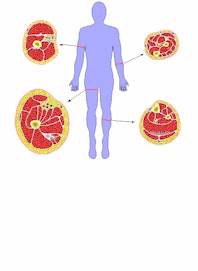Cross-Sections of Muscles of the Arm and Leg

Between the skin on the surface and the bones that provide stability within, the arms and legs are substantially composed of muscle (and the tendons and ligaments that connect them) that serves to stabilize and empower those limbs and with them the body as a whole. Control of the muscles---in standing and moving or grasping and manipulating---is not something that we are born with. Babies gradually learn coordination and control of their muscles from the head down: the muscles of the neck, the shoulders and arms, and then the body. The last muscles the baby masters are those of the pelvis and legs, which make standing and walking possible.
Rarely do the muscles of the arms or legs work independently. Muscles called prime movers, such as the deltoid muscles in the shoulders, are powerful initiators of force. Because the prime movers' contractions result in movement, they are called agonists. Their action is then opposed by muscles called antagonists; i.e., any muscle that extends a limb is acting against the muscle that flexes or bends. The triceps in the upper arm is antagonistic to the biceps when the arm is bent at the elbow. Such paired muscles make possible the cooperation necessary in smooth muscular efforts. Assistant movers, which contribute a specific movement, often assist the prime movers. The hamstring muscle of the thigh is the prime mover in bending the knee, the sartorius is the assistant, and the group of muscles forming the quadriceps is the antagonist. A stabilizer muscle holds a bone or other part of the body steady to provide a foundation upon which the muscles can pull. Plenty of these are necessary, as the placing of one foot in front of the other is a process of constantly losing and regaining balance as each step finds a new base. Synchronizing movements of the arms and legs, the muscles ensure that balance is restored before the body falls over.
Legs and arms work like levers, pivoting on fulcrums of ankles, shoulders, and hips. Muscles working together produce power, and the muscles then exert this power upon the points where they are connected to bones. The bones, then, linked by joints, form lever systems. The muscles of the arms and legs create these levers through the major joints of the extremities---the shoulders, elbows, hips, and knees---all of which are complex musculoskeletal machines. For instance, the knee joint is a complex hinge joint. Condyles and epicondyles of the knee (as of the elbow) serve as sites for muscle and ligament attachment where the power of the muscles can be transferred to the strength and rigidity of the bones. In this way, the muscles of the arms and legs give the body its power and dexterity.


